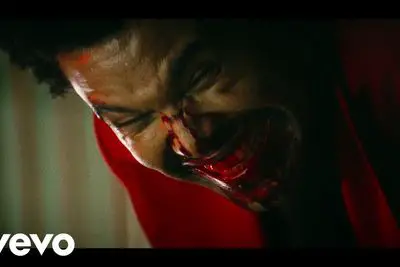On “After Hours,” The Weeknd‘s Toxicity Becomes Tiresome
The crooners first album in four years sounds great, but his lack of remorse is becoming a concern

In the 2012 visual for "Rolling Stone," Abel Tesfaye, otherwise known as enigmatic R&B crooner The Weeknd, presented his fans with a symbolic interpretation of an existential crisis he faced as a budding superstar.
"The Rolling Stone video takes place in a dimly lit studio which represents the two worlds I have been stuck in," he wrote in a statement to his fans. He was about to sign his first major record deal, and he knew that his mysterious persona no longer suited him. "The camera lights symbolize the crossover, and when they begin to flash I look away from the underground...even though I don't want to." But on his major-label debut Kissland, Tesfaye still clung to the shadows. The project was purposefully devoid of catchy choruses and melodic structure, and while the project developed a massive cult following as a result, it boxed The Weeknd into one particular aesthetic.
To step out of his own way, he enlisted the talent of pop sovereign Max Martin for "Can't Feel My Face," a song that would skyrocket Tesfaye into the pop stratosphere. "Abel Tesfaye used to be a drugged-out R&B mystery man. Now he wants to be your Michael Jackson," wrote Rolling Stone. His career since that monumental moment has straddled the line between pre- and post- "Can't Feel My Face," between amorphous R&B and tightly made pop singles produced alongside legends like Martin and Daft Punk.
On After Hours, the comparisons to the late King of Pop no longer seem to suit Tesfaye. The album is devoid of danceability and instead is presented as a return to form. He's spent the last few years embracing the mainstream success he once was so afraid of, and in hindsight, the singer now criticizes the naivety of his decision. "I'm living someone else's life, suppressing who I was inside," he calls out on "Alone Again." "Cali was the mission but now a n***a leaving," he croons on "Snowchild"–a reference to a similar testament made on his 2011 single "The Morning."
The darkness has always been Tesfaye's ally, so it makes sense he would retreat back into the shadows when the going gets tough. For four years, he was absent from Instagram, declined interviews, and once again became a recluse. When he reemerged, his aesthetic had drastically shifted from the clean-cut, sober epochs of Starboy to a manic, strung out, cigar-lover who harbors a collection of unexplained cuts and bruises. Yet while the songs on After Hours flow in similar shapeless fashion to The Weeknd's magnum opus, the efforts aren't nearly as bewitching as they once were.
He constantly gaslights his ex-lovers (presumably Bella Hadid and Selena Gomez,) at moments pledging to change, ("After Hours") before diving into anecdotes of how he will always be an emotionally abusive addict ("Heartless"). Sure, there is a tinge of remorse scattered throughout, and he's clearly aware that his behavior is detrimental to those around him; but, thematically, the melodramatic saga of The Weeknd has become a tiresome caricature.
In 2019's "Lost in The Fire," Tesfaye crooned that an ex of his should bring her girlfriend over so he can "f*ck" them "straight." Lines like that are problematic in essence, but they've always been excused because it's just "who The Weeknd is." Aren't we supposed to be past all that? Isn't being a damaged man no longer a valid excuse to behave poorly? Here's to hoping that, as time goes on, The Weeknd doesn't devolve into a relic of the cultural past.
After Hours